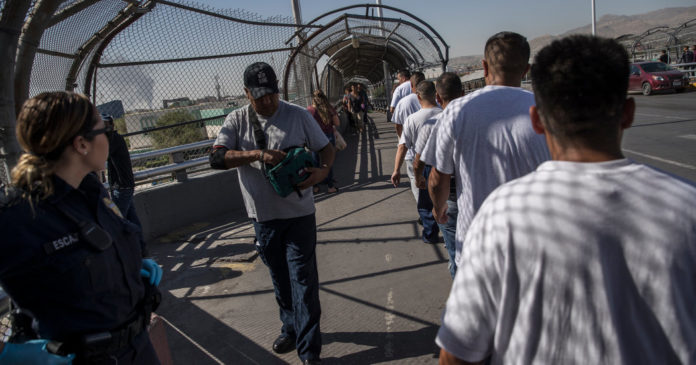LONDON — Major political conflicts are playing out both in the United States and in Europe over immigration and refugees. While the clashes might look similar on the surface, and do in fact share much in common, they’re also different in subtle but crucial ways.
A side-by-side comparison suggests that while the conflicts are sometimes about immigration itself, often they have more do with race and ethnic identity — or with simple politics.
Why is the migrant issue flaring up now?
What’s similar between the U.S. and Europe: Despite the urgent tone on both sides of the Atlantic, the renewed calls to control unauthorized immigration are not tied to any actual surges at the borders.
In the United States, in fact, border crossings have been low for years, and in Europe they are now far lower than they were at the peak of the refugee crisis a few years ago. Rather, the migrant crisis is a backlash against migrants and refugees, and the political fights and extreme policies that has set off.
The anger, research suggests, often stems less from migration specifically than from a broader anxiety over social change. When people feel a sense of threat or a loss of control, they sometimes become more attached to ethnic and national identities.
For some people, the antipathy is explicitly racial. But for many others, the mere fact of cultural change itself can be unsettling. Immigration, unauthorized or otherwise, is just one of the changes that bring about a feeling of the loss of control. Economic dislocation, changes in social hierarchies and demographic change can all produce the same effect.
But when asylum seekers arrive without permission or warning, that can add to the sense of anxiety by making the border — perhaps the most obvious symbol of national identity and territorial protection — seem weak.
On both sides of the Atlantic, migrants and asylum seekers have become, for many voters, a symbol of the political establishment’s failure to protect them and their interests.
What’s different: In the United States, where the federal government has centralized control over immigration policy, President Trump has been able to translate the anti-migrant backlash into policy, including by separating families at the border.
But in the European Union, which has 28 member states, the crisis is more complex, touching on the bloc’s need for political unity. There is also the challenge of addressing the status of migrants and refugees not just at the external borders where they arrive but also within Europe after they have crossed a border.
There is a deep conflict over what European policy should be between some front-line countries like Italy, which see themselves as carrying an unfair burden as migrants arrive after crossing the Mediterranean, and countries like Hungary and Germany that strongly resist taking in additional asylum seekers.
Why is the problem is so difficult to resolve?
What’s similar: Efforts to “solve” unauthorized border crossings have highlighted a central political contradiction: American and European Union law requires governments to let refugees apply for asylum no matter how many arrive. But the politics of migration demands some sort of limits on their numbers.
The only way to resolve that contradiction without violating the law — its letter if not its spirit — is by preventing people from arriving or deterring them from setting out on their journeys in the first place.
There is also a contradiction between old ideas of national identity, which were rooted in fixed demographics, versus a modern world in which international migration is more possible than ever.
But because public demand for harsh immigration policies is often driven by a broad range of social changes and issues, and not just migrants, whatever policies end up being enacted can never quite satisfy those who had demanded them.
What’s different: The Trump administration has been upfront about its deterrence goal. It has used family separations and prosecutions as a way to discourage those with a mind to try to relocate to the United States.
Mr. Trump went further last week, calling for immigrants to be denied due process. That “long and complicated legal process,” he said on Twitter, “is not the way to go.” Instead, he said, “people must simply be stopped at the Border and told they cannot come into the U.S. illegally.” For the moment, at least, the president does not seem to be making an actual policy proposal.
European leaders have been more circumspect in their public statements, but they also have pursued policies that deter asylum claims by making the crossing too dangerous or impossible for migrants to attempt. They have worked with the governments of Sudan and Libya despite evidence of serious human rights abuses in those countries.
Where is the crisis leading for migrants?
What’s similar: For both migrants and those hoping to obtain refugee status, the politics of the crisis point to greater hardship.
As long as people believe they face greater danger and hardship in their home countries than they would elsewhere, many will set out for new lands. Neither the United States nor Europe appears focused on easing the crises in Central America, the Middle East and other regions from which people flee. So policies intended to deter arrivals are likely to do little more than worsen the perils for migrants.
What’s different: Political and geographic differences between the United States and Europe mean that the nature of this hardship, and which groups of migrants are at greatest risk, will vary.
Those traveling to Europe face a growing risk of being swept up in countries like Libya or Sudan that have cut deals with Europe to limit migration. Those governments, or militias working with them, have imposed tremendous suffering on migrants. Some migrants, reports say, have even been sold as slaves.
But because the abuses happen far from European soil and are not committed by European officials directly, they have been easy for the public to ignore.
The migrant trek to the United States is also dangerous, but the Mexican government is less willing to go to Libyan-style extremes. The likely winner of next month’s Mexican presidential election has said he will not cooperate with the United States to cut off migration routes.
So, unlike Europe, the United States must conduct much of the work of its border enforcement and deterrence policies itself.
The Trump administration, deliberately or not, has been testing the limits of American tolerance for extreme border enforcement, for instance by separating parents from their children. Those policies have drawn considerable public attention and protest, becoming a focus for political conflict.
Which Future Will They Choose?
What’s similar: Both Europe and the United States are facing an especially sharp version of a choice that has divided their populations for decades: What sort of society do they wish to be? Do they wish to be immigrant nations with continual demographic and cultural change? Or do they wish to keep their national identities fixed?
The question is divisive, so both American and European leaders have long sought compromises that don’t fully resolve the matter. But that has baked contradictions into their immigration systems that make repeated controversies inevitable — and it’s not clear whether that can continue indefinitely.
As immigration and differing birthrates make countries less white, this conflict over national identity is increasingly dividing politics in both the United States and Europe.
What’s different: Those politics are playing out very differently in the two systems, putting them under very different sorts of strain.
In the United States, most voters are growing more tolerant of immigration, but a committed minority is increasingly demanding limits on immigration in all forms. Because that minority makes the issue a top priority, it holds considerable power over policy.
The two-party American system means that the issue has polarized voters. Both sides see the United States’ core character as at risk of being destroyed. That feeling of existential, zero-sum conflict can make people feel that extreme action is justified to prevent victory for the other side, undermining democratic norms.
Europe’s political crisis looks different. Establishment leaders like Chancellor Angela Merkel of Germany, seen as responsible for the crisis, are at risk of losing power. Populist leaders who promise to overturn the status quo are gaining it.
This is putting the European Union itself at greater risk.
At the moment, the bloc does not have the power to redistribute asylum obligations to take pressure off border countries like Italy and Greece. Doing so would require new powers, or the consent of all member states, but there is little public support for either amid the frustration and fear over migration.
It is possible that the United States and the European Union could each find immigration policies just palatable enough to forestall greater political breakdown. But that will not solve the underlying question of what place immigrants have in American and European societies. It is more polarizing than it has been in years.
Source : Nytimes












